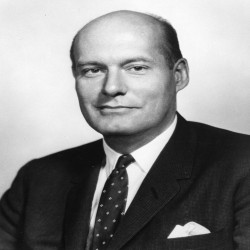
Nicholas Katzenbach
Former United States Attorney General
| Date of Birth | : | 17 January, 1922 |
| Date of Death | : | 08 May, 2012 (Aged 90) |
| Place of Birth | : | Philadelphia, Pennsylvania, United States |
| Profession | : | Lawyer |
| Nationality | : | American |
Nicholas Katzenbach (নিকোলাস কাটজেনবাখ) was an American lawyer who served as United States Attorney General during the Lyndon B. Johnson administration. He previously served as United States Deputy Attorney General under President John F. Kennedy.
Early Life and Education
Katzenbach was born in Philadelphia and raised in Trenton. His parents were Edward L. Katzenbach, who served as Attorney General of New Jersey, and Marie Hilson Katzenbach, who was the first female president of the New Jersey State Board of Education. His uncle, Frank S. Katzenbach, served as Mayor of Trenton, New Jersey, and as a Justice of the New Jersey Supreme Court.He was named after his mother's great-great-grandfather, Nicolas de Belleville (1753–1831), a French medical doctor who accompanied Kazimierz Pułaski to America and settled in Trenton in 1778. Katzenbach was raised an Episcopalian and was partly of German descent.He attended Phillips Exeter Academy and was accepted into Princeton University. Katzenbach was a junior at Princeton in 1941, enlisting right after Pearl Harbor, and served in the United States Army Air Corps in World War II. Assigned as a navigator in the 381st Bomb Squadron, 310th Bomb Group in North Africa. His B-25 Mitchell Bomber was shot down on February 23, 1943, over the Mediterranean Sea off North Africa. He spent over two years as a prisoner of war in Italian and German POW camps, including Stalag Luft III, the site of the "Great Escape", which Katzenbach assisted in. He read extensively as a prisoner and ran an informal class based on the Principles of Common Law.
He received his A.B. cum laude from Princeton University in 1945 (partly based on Princeton giving him credit for the 500-odd books he had read in captivity).[6] As part of his degree, Katzenbach completed a senior thesis titled The Little Steel Formula: An Historical Appraisal.[9] He received an LL.B. cum laude from Yale Law School in 1947, where he served as editor-in-chief of the Yale Law Journal. From 1947 to 1949, he was a Rhodes Scholar at Balliol College, Oxford.On June 8, 1946, Katzenbach married Lydia King Phelps Stokes, in a ceremony officiated by her uncle, Anson Phelps Stokes, former canon of the Washington National Cathedral. Her father was Harold Phelps Stokes, a newspaper correspondent and secretary to Herbert Hoover.Katzenbach was admitted to the New Jersey bar in 1950 and the Connecticut bar in 1955. He was an associate in the law firm of Katzenbach, Gildea, and Rudner in 1950.
Government service
From 1950 to 1952, he was an attorney-advisor in the Office of General Counsel to the Secretary of the Air Force. Katzenbach was on the faculty of Rutgers Law School from 1950 to 1951; was an associate professor of law at Yale from 1952 to 1956; and was a professor of law at the University of Chicago from 1956 to 1960.He served in the U.S. Department of Justice as Assistant Attorney General of the Office of Legal Counsel in 1961–1962 and as Deputy Attorney General appointed by President John F. Kennedy in 1962. After the assassination of President Kennedy, Katzenbach continued to serve with the Johnson administration. On February 11, 1965, President Johnson appointed Katzenbach the 65th Attorney General of the United States, and he held the office until October 2, 1966. He then served as Under Secretary of State from 1966 to 1969. While Under Secretary of State, he commented on the 1967 USS Liberty incident: “There was nobody I think who did not believe that the Israelis knew it was an American ship that they were attacking.”In September 2008, Katzenbach published Some of It Was Fun: Working with RFK and LBJ (W. W. Norton), a memoir of his years in Government service.
The Stand in the Schoolhouse Door
On June 11, 1963, Katzenbach was a primary participant in one of the most famous incidents of the Civil Rights struggle. Alabama Governor George Wallace stood in front of Foster Auditorium at the University of Alabama in an attempt to stop the desegregation of that institution by the enrollment of two black students, Vivian Malone, and James Hood. This became known as the "Stand in the Schoolhouse Door". Hours later, Wallace stood aside only after being ordered to do so by Alabama National Guard General Henry V. Graham.
Role in JFK assassination investigation
Katzenbach has been credited with providing advice after the assassination of John F. Kennedy which led to the creation of the Warren Commission. On November 25, 1963, he sent a memo to Johnson's White House aide Bill Moyers recommending the creation of a Presidential Commission to investigate the assassination. To combat speculation of a conspiracy, Katzenbach said the results of the FBI's investigation should be made public. He wrote, in part: "The public must be satisfied that Oswald was the assassin; that he did not have confederates who are still at large".Four days after Katzenbach's memo, Johnson appointed some of the nation's most prominent figures, including the Chief Justice of the United States, to the Commission. Conspiracy theorists later called the memo, one of the thousands of files released by the National Archives in 1994, the first sign of a cover-up by the government.
Quotes
Total 0 Quotes
Quotes not found.